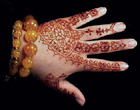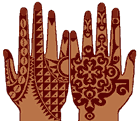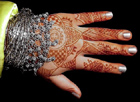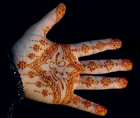|
Many traditional African patterns balance contrasting dark and light areas of henna and skin rather than relying on a dark line on pale skin to create pattern. Fine henna lines may be difficult to see on dark skin. Broader areas of henna can be given heavier applications than single lines, and get more intense contrast to the skin color. Including the essential oils with high levels of monoterpines will add to color intensity. The African aesthetic fondness for asymmetry and bold patterns creates dramatic henna! Other women of color have honey-toned skin that harmonizes beautifully with henna. These women may choose redder or browner hennaes, both will give contrast and definition with fine lines. Use different essential oils, different line thickness, heating and duration of application to create different tones on skin. |




